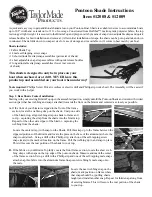
6.
Preparation of the spacer
Preparation of spacer according to dimensions
E
,
P
and
R
– see Fig. 3 and
Tab. 2
Spacer Jaw
A D
T
opening
E
mm/"
PxR
mm/"
C
mm/"
Minimum Optimum Minimum Optimum
HV 515
390
(15,35")
E
=
B
-
F
-13
(
E
=
B
-
F
-0,52")
200x100
(8"x4")
C
=
B
+50
(
C
=
B
+2")
200
(8")
350
(14")
30
(1,18")
50
(2")
HV 516
550
(21,65")
E
=
B
-
F
-11,5
(
E
=
B
-
F
-0,45")
260x130
(10,24"x5,12")
C
=
B
+80
(
C
=
B
+3,15")
300
(12")
500
(20")
30
(1,18")
50
(2")
7. Vice installation on a workbench including additional jaws
Required tools:
- handheld drill / bench top upright drill
- wood drill bit
∅
: 3, 4, 5, 6, 18, 20, 30 mm (0,12
", 0,16", 0,2", 0,24", 0,71", 0,79", 1,18")
- manual / electrical screwdriver – depending on type and size of used screws
- wood saw
- screw vice / C-shaped clamp – 2 pcs
- hammer / mallet
a) If the workbench has no collar and we use an additional rear jaw by fixing it to the relevant position
on the front edge of the workbench. The number and size of screws must be adequate to the additional
rear jaw size. The presumed number of wood screws is 5-7,
∅ 6−8
mm (0,24“-0,32“)
. Fix the rear jaw
so that the top edge is flush with the top of the workbench board. If the workbench has a collar, drill
holes for the spindle (3) and guide rods (5) directly into the collar. See Fig. 5.
Page 5 (of 7)
Fmin
E
30mm
(1,18
")
B
A
T
T
C
2°
D
R
P
Fig.4
Tab.2

























